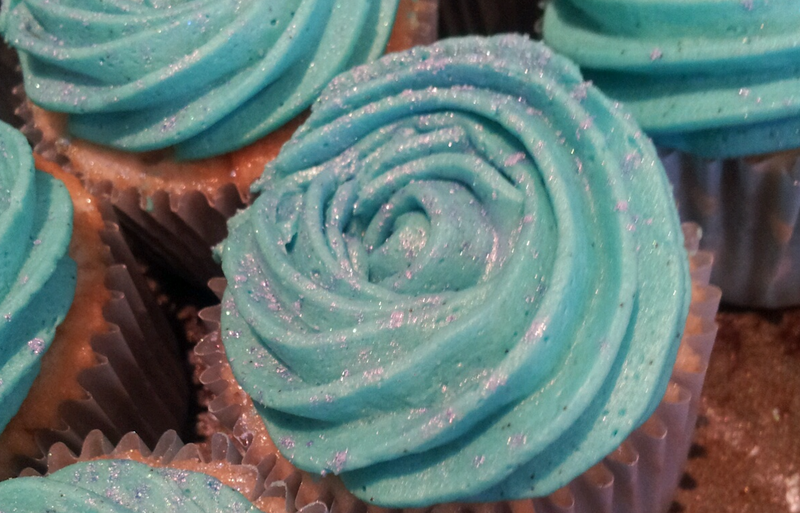Plastic is not so fantastic on a cupcake
Updated | By Wendy Knowler
There’s no gentle way to say this, cake lovers - that shimmering, glamorous, brightly coloured glitter has no place on cake icing - it’s plastic and shouldn’t be eaten.

Listen to this week's consumerwatch below, or read the details under the podcast.
It’s become commonplace because the cake decorating industry isn’t being regulated, and bakers - both home bakers and commercial cupcake makers - mostly don’t know about labeling laws and aren’t asking questions.
I asked a local cupcake outlet, Kupcake Heaven, what they know about the glitter that’s on some of their elaborate cakes. Ask our supplier, I was told.
So I did - Party Themes in Springfield. An employee there told me they got their glitter from three suppliers, among them, Aragon.
“The label says ‘Strictly for decorative purposes, non-toxic’.” I was told. But the two terms seem contradictory and confuse consumers.
If the glitter is only for decoration, I’d like to see someone try to remove it from icing.
Adding to the confusion, the Party Themes man told me you can sprinkle the glitter onto icing; you just mustn’t eat it from the container.
Nonsense, says the owner of Aragon, Wayne Sher.
It turns out he’s stopped supplying KZN stores with glitter - all but one which is effectively its franchise store - because it’s not being used as intended.
“It’s supposed to be applied to removable cake decorations,” he said. “But instead it’s being sprinkled liberally everywhere.”
And some of the stuff is carcinogenic.
Lovely.
Sher - who has been in the cake decoration goods business for 20 years, and exports to 19 countries - has been on something of a crusade about the misuse of inedible, non-food grade cake decorations for quite a while.
Last November he posted on Facebook: “The fact that people throw these products all over cakes and then eat them is wrong, especially when cake decorators use these items and the person buying the cupcakes and cakes have no idea that these are really not a food item. People have the right to know!”
As for suppliers calling their products “Food Touch Safe”, he said, that doesn’t mean they are edible.
“Do not eat!” would be more accurate advice for consumers, if you ask me.
Sher’s sentiments are shared by Ian Youll of Cape Town-based decorations maker, Nicoletta, who has had many products on the local market tested by an independent lab, which found them to be plastic.
“We have found no brightly coloured glitter that can be backed up with food grade certification from a reputable certification partner,” he said.
“The fact that they are sold in baking shops and labeled “non-toxic’ or “food contact safe” does not absolve the brand or the store selling the product of their responsibility to look after the consumer. The product should not be eaten, it should not be used on products that are going to be eaten! It is that simple."
Sher had some other awful revelations to share:
- Most rose gold “edible” leaf or foil is not at edible at all, he says. “It’s okay to use the non-edible leaf on removable parts of a cake but does a baker tell this to their client? No,” he said.
- "A cake decorating company on the East Rand sells gold dust as non-toxic, when it is in fact printer’s ink," Sher says.
This week, the UK’s Food Safety Agency, the FSA, dropped a bombshell about cake decorating products made by a very prominent South African company.
It issued an advisory about the entire range of cake decorating products produced by Rolkem, saying the company had “failed to provide assurances of product safety", and thus there was a potential risk that they could contain "heavy metals, unapproved non-food pigments and/or other unapproved ingredients”.
Earlier this year, a batch of two Rolkem gold colours were recalled from the UK market after being found to contain high levels of copper.
CEO Andries Kemp says the company couldn’t meet the FSA’s unrealistic deadlines regarding test certificates on all its 400 different products. “We shall supply the test certificates to all our stockists locally and internationally as soon as we receive it from the laboratory,” he said in a statement.
“We are confident that all products shall test clear.”
What to do:
- Avoid cake decorating products with illegal labels: the label must have a full list of ingredients, a batch number, 'best before' date and the supplier’s name and contact details.
- Those making cupcakes to sell should ask their suppliers to produce their certificate of compliance and an MSDS - materials safety data sheet. And ask if they test their raw ingredients themselves rather than taking their supplier’s certifications at face value.
- If you’re buying the finished product, don’t eat the stick-on decorations, and avoid those with bright glitter sprinkled directly on to the icing altogether.
*To get in touch with Wendy, email her via her Facebook page - wendyknowlerconsumer. Use the email button.
Show's Stories
-
5 moments you can't miss from East Coast Breakfast
Viral moments that we had to re-share...
East Coast Breakfast 20 minutes ago -
SA cinemas jack up prices but can they win you back in other ways?
Cinema ticket prices are soaring but can blockbusters and live events lu...
Stacey & J Sbu 17 hours ago